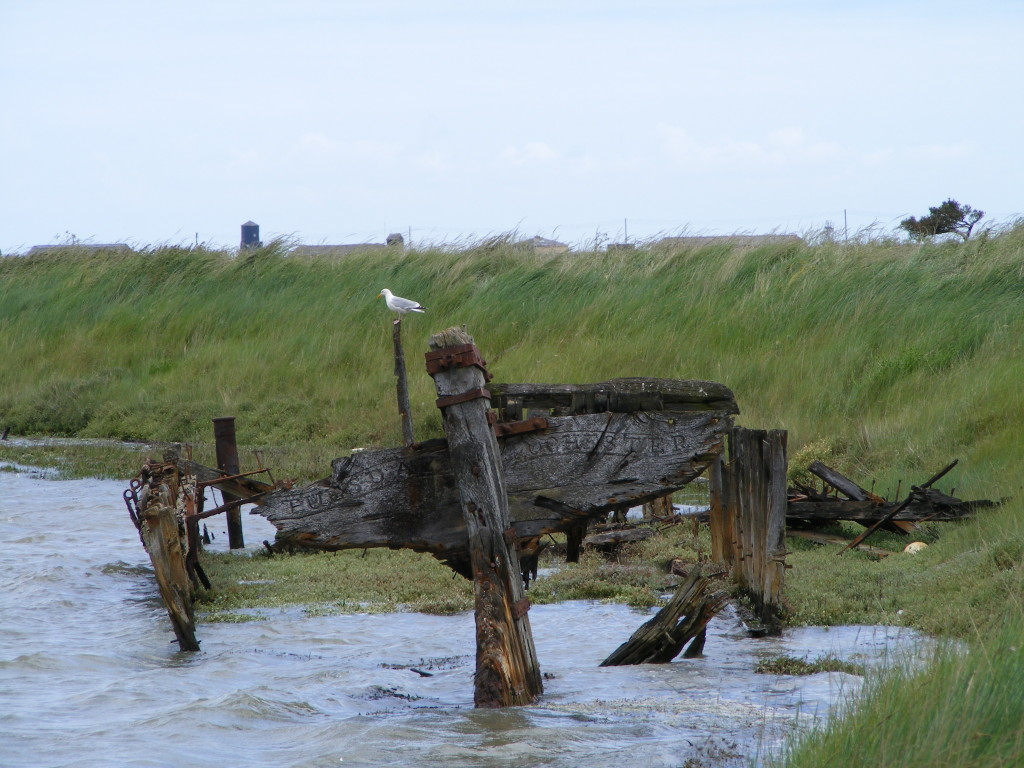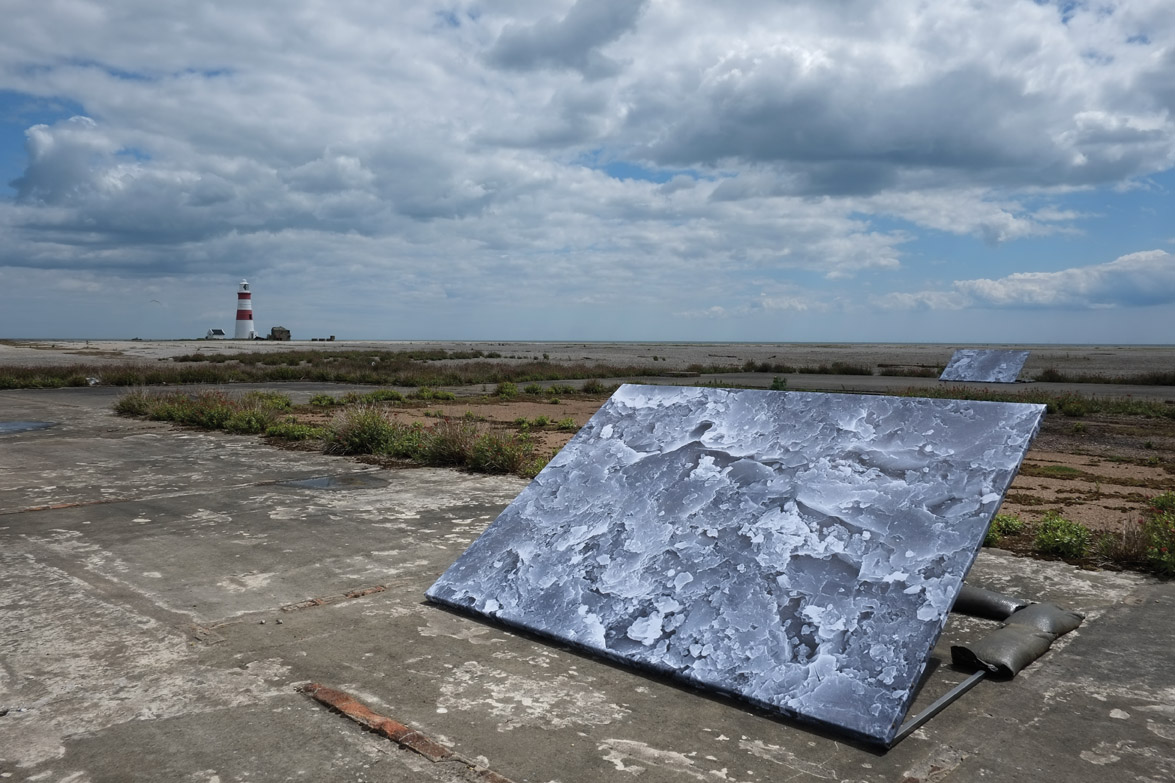Like many stories, this one begins with a rock, in fact one rock amongst many: the shifting shingle which geographically defines and continually redefines the salt marshes of Orford Ness. When contemporary artist Anya Gallaccio made her first trip to the shingle spit of the Ness, it was not the accidental sculptures of wire and curled sheet metal (rusted by salt-winds) which captured her imagination, but the stony beach desert on which they lie, abandoned like military driftwood.
When we arrive for SNAP on the National Trust ferry out to the Ness, our faces glittering with salt water spray, Gallaccio recalls the illicit exchange of a bag of shingle in Fortnum and Mason, miles away from the flat-lining whistle of the Suffolk coast. Back in the Snape Maltings a photograph records the forbidden transaction: a plastic bag of assorted rocks tied up with a paper label: “For Anya Gallaccio”.
But none of them were quite right. Gallaccio was looking for a rock whose stony matter could link the unique ecology of Europe’s largest vegetated shingle spit to its incongruous history as a testing ground for the MOD. She imagined the Ness’ shingle as being somehow ‘shell-shocked.’
Eventually one of the National Trust workers found her the perfect specimen, marked by the traces of an explosive trauma: the rock had been taken from the inside of a crater recently blasted in a controlled explosion of live ordnance. Gallaccio smashed this rock and spent hours looking at six or seven of the traumatised fragments, which were magnified 20,000 times under an electron microscope. She was searching for strange landscapes which recalled the Ness, the aerial photography tests made by the MOD on the site, and imagined aerial surveys of war-torn battlefields.
The frames she selected were then printed onto large mesh canvases and returned to be installed in their original landscape. Here, they tilt backwards like mirrored panels designed to disorientate our sense of perspective. They force us to zoom in and zoom out on a seemingly endless series of landscapes within the landscape. Our eyes must schizophrenically refocus again and again as what appears to be a vast greyscale aerial panorama turns out to be a shrinking microscopic fleck of landscape viewed through the lens of a single pebble. The history of Orford Ness isn’t just contained within the remaining structures, decorated with laminated info-points, it is also preserved – invisible to the naked eye – in every shifting piece of shingle.
MoD laboratories are now left spaceship-like, burrowed into the shingle. The land is still fertile with rumour and conspiracy.
The movement of the rocks through tidal drifts and seasonal storms makes the environment ideal for an artist inspired by the ephemeral, the decaying: the natural flux of the world. It is thought that soon the Ness will be an island, completely cut off from its coastal neighbours. The lighthouse, which is slowly being pulled closer to the waves’ edge, was switched off last year despite having been a permanent fixture since 1637; the diesel generator and bath of mercury were removed in anticipation of its inevitable slip into the sea in several years’ time. The question of how to record both its history and its ecology seems to be a topic of equal fluctuation.
It is only when we arrive back on dry land in the town of Orford that we fully comprehend the distance that two-minute ferry ride took us, to Orford Ness. It is only with our cheeks flushing that we realise how much the winds have battered us, and the salt-air dehydrated us; how different the weather conditions are on the river-front of civilisation – with its moored sailboats and Regardless River Trips – compared to the harsh conditions of the spit. The Ness is already a world isolated, remote: all that can be seen from Orford is the flat line of the opposite shore. Even though the area is now accessible to the public (ever since the National Trust took over the site in 1993) I wonder how many local residents have visited.

Gallaccio admits that the installation is also a good excuse to get people to come out and see the surreal site. On the day that I visit sea-cloud and sky-cloud are separated by a thin bow of blue. The sunshine, like a searchlight, revolves across the shingle, picking out the colours of flowering pink Sea Thrift, Yellow Horned Poppies, poisonous Ragwort, and the orange lichens which grow on the concrete exoskeleton of unnamed structures.
The reed and salt marshes, the brackish lagoons, mud-flats, shingle ridges and heath: all seem to roll onwards towards the tidal edgelands which lie beyond our reach, both because of the unexploded ordnance hidden beneath the pebbles and the fragility of the shingle’s vegetation. We aren’t lucky enough to see any Chinese Water Deer, but we do spot two hairy caterpillars stretching and gathering themselves onwards along the official pathway.

Although many of the buildings like the ‘Power House’, ‘The Black Beacon’ and the typical red and white candy-cane of the Lighthouse have obvious functions; there are others, such as the concrete circle of a ghosting foundation, which remain unexplained – shrouded in redacted Ministry of Defence secrecy. In the 1950s the MoD built several laboratories with fifteen-feet thick walls for the vibration testing and drop testing of nuclear weapons. The laboratories are now left spaceship-like, burrowed into the shingle. The land is still fertile with rumour and conspiracy.
In this context the fractured surfaces of Gallaccio’s rockscapes leave themselves open to their own interweaving of new whisperings and fabrications. Her exploded rock, weighed down by industrial sandbags on its canvases, displays history like a ravaged landscape marked by each of its events.
As I come down from the Black Beacon observation tower I notice a hag stone amongst the shingle, shaped like a fruit pip, speckled orange, and worn through with a perfect hole for looping a piece of string. My journey to the Ness begins and ends with the story of a single rock.
Anya Gallaccio’s installation is part of SNAP Art at the Aldeburgh Festival, 14th – 29th June, 2014. A co-commission by Aldeburgh Music and 14-18 Now WW1 Centenary Art Commissions, 1418now.org
Image credits, top to bottom:
1. Anya Gallaccio ‘Untitled Landscapes’ 2014. Installation at Orford Ness, SNAP 2014.Photo: Owain Thomas. Courtesy of Aldeburgh Music and the National Trust.
2-4. Francesca Brooks


